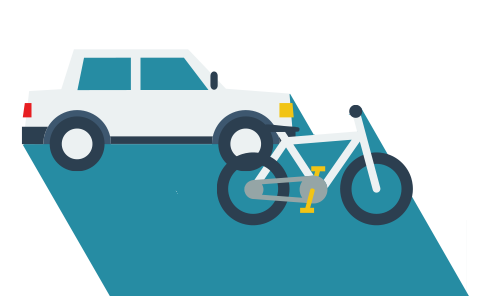

Transportation |
RESEARCH OVERVIEW
Automobile use in the developed and developing world is driving environmental, health, and quality of life impacts in and around cities, from greenhouse gas emissions, to pollution and traffic accidents, to long commutes and heavy congestion. Mobility futures in urban areas will need to evolve away from their existing form in order to avoid continued negative outcomes. Autonomous (self-driving) vehicles (AVs) are an emerging technology that may drive much of this change. However, in the absence of suitable policy and planning, widespread use of self-driving vehicles could significantly increase motorized travel and many of its associated impacts.
Part of the urban mobility challenge will require shifting the public’s mode choices toward transit, biking, walking, and vehicle sharing (car-, bike-, or ride- sharing). This requires understanding human motivation at the individual and household scale, as well as understanding the land use patterns at a community and citywide level that are conducive to sustainable forms of urban mobility. At the city and regional scales, it is important to understand which factors shape how cities coordinate sustainable land use-transportation planning and finance in metropolitan planning organizations and across the governments and authorities within their boundaries.
The network’s transportation-related work is concerned with better understanding these, as well as other, multi-scale factors affecting sustainable mobility futures, while also making connections to key societal outcomes and pathways of change.
OUR PRODUCTS
How the built environment influences biking and walking
- November 2020
- Journal Brief
- Author: Multiple
Active travel—biking and walking instead of driving—is important to both public health and the environment. This study sought to understand the collective influence of built environment features, such as distance … Read more
Public interest in self-driving vehicles
- November 2020
- Journal Brief
- Author: Multiple
As improvements in automated vehicles (AVs) make them an increasingly viable mode of transportation, what types of people will use them? This journal brief summarizes results from two surveys that … Read more
Exploring the Nonlinear Relationship between the Built Environment and Active Travel in the Twin Cities
- May 2020
- Peer-Reviewed Articles
- Author: Multiple
Tao, T., Wu, X., Cao, J., Fan, Y., Das, K., & Ramaswami, A. (2020). Exploring the Nonlinear Relationship between the Built Environment and Active Travel in the Twin Cities. Journal … Read more
Explaining transit expenses in US urbanised areas: Urban scale, spatial form and fiscal capacity
- January 2020
- Peer-Reviewed Articles
- Author: Multiple
Zhao, Z, Feiock, R., Shen R., Lou, S., & Fonseca, S. (2020). Explaining Transit Expenses in US Urbanized Areas: Urban Scale, Spatial Form, and Fiscal Capacity. Urban Studies, doi: 10.1177/0042098019892582. … Read more
Exploring the non-linear associations between spatial attributes and walking distance to transit
- January 2020
- Peer-Reviewed Articles
- Author: Multiple
Tao, T., Wang, J., & Cao, X. (2020). Exploring the non-linear associations between spatial attributes and walking distance to transit, Journal of Transport Geography, 82, 102560. ABSTRACT: When examining environmental … Read more
Identifying Thresholds for When Built Environment Variables Affect Transportation CO2 Emissions
- October 2019
- Journal Brief
- Author: Multiple
This journal brief explores the how thresholds related to built environment characteristics affect transportation-related CO2 emissions. Download the two-page journal brief. This brief is adapted from the following peer-reviewed journal … Read more
Making Strategic Investments in Bike Share Stations to Increase Usage
- August 2019
- Journal Brief
- Author: Jueyu Wang and Greg Lindsey
Does the installation of more bike share stations increase use of the system among members? If so, is the effect the same for all members, in all areas of the … Read more
How does the built environment affect interest in the ownership and use of self-driving vehicles?
- June 2019
- Peer-Reviewed Articles
- Author: Multiple
Nodojomian, A. & K. Kockelman. (2019). How does the built environment affect interest in the ownership and use of self-driving vehicles? Journal of Transport Geography, 78, 115-134. ABSTRACT: Connected and … Read more
Exploring the importance of transportation infrastructure and accessibility to satisfaction with urban and suburban neighborhoods: An application of gradient boosting decision trees
- April 2019
- Peer-Reviewed Articles
- Author: Jason Cao and Xinyi Wu
Cao, J. & X. Wu. (2019). Exploring the importance of transportation infrastructure and accessibility to satisfaction with urban and suburban neighborhoods: An application of gradient boosting decision trees. Transportation Findings, … Read more
Do New Bike Share Stations Increase Member Use: A Quasi-Experimental Study
- March 2019
- Peer-Reviewed Articles
- Author: Jueyu Wang and Greg Lindsey
Wang, J. & G. Lindsey. (2019). Do New Bike Share Stations Increase Member Use: A Quasi-Experimental Study. Transportation Research Part A: Policy and Practice, 121, 1-11. ABSTRACT: As the number … Read more
Understanding Trip Happiness using Smartphone-Based Data: The Effects of Trip- and Person-Level Characteristics
- February 2019
- Peer-Reviewed Articles
- Author: Yingling Fan, Rowland Brown, Kirti Das, Julian Wolfson
Fan, Y., Brown, R., Das, K., & J. Wolfson. (2019). Understanding Trip Happiness using Smartphone-Based Data: The Effects of Trip- and Person-Level Characteristics. Transport Findings, 10.32866/7124. ABSTRACT: Understanding trip happiness—a … Read more
Science-Policy Dialogue Report No. 1- Distributed and Localized Infrastructure in Cities
- September 2018
- Report
- Author: Multiple
The localization and decentralization of key infrastructure systems has emerged as a potential strategy for helping cities achieve multiple sustainability outcomes spanning environment, economy, health, wellbeing, and equity. Examples of … Read more
Electric, Autonomous, and Shared Vehicle Technology Adoption
- August 2018
- Journal Brief
- Author: Neil Quarles and Kara Kockelman
With the ongoing advancement of electric, autonomous, and shared vehicle technologies, how readily will Americans adopt these technologies, and what are their opinions towards them? A survey of 1,426 adult … Read more
Using three-factor theory to identify improvement priorities for express and local bus services
- July 2018
- Peer-Reviewed Articles
Wu., X., Cao., J. & J. Huting. (2018). Using three-factor theory to identify improvement priorities for express and local bus services: An application of regression with dummy variables in the … Read more
Sustainable Urban Infrastructure Transitions in the ASEAN Region: A Resource Perspective (UN Environment and Sustainable Healthy Cities collaboration)
- February 2018
- Report
- Author: Multiple
The ASEAN nations are a hot spot for rapid urbanization over the next 30 years: Between 2015 and 2050, ASEAN cities are projected to add 205 million new urban residents … Read more
The Weight of Cities: Resource Requirements of Future Urbanization (International Resource Panel report with Sustainable Healthy Cities contributing authors)
- February 2018
- Report
- Author: Multiple
Over the next 30 years, an additional 2.4 billion people are likely to be added to the global urban population. This increase in population will result in a significant expansion … Read more
Estimating Bicycle Infrastructure
- February 2018
- Video
- Author: Greg Lindsey
One of the questions the Department of Transportation officials and state policy-makers face is how much to invest in bicycle infrastructure. Estimating how much bicycling occurs in a state may … Read more
Happy Cities: The Role of Transportation
- November 2017
- Video
- Author: Yingling Fan
Increasing psychology research suggests that emotional well-being contributes to human development in significant ways. Happier people often are more productive and creative, have better family and social relationships, and in … Read more
Waiting Time Perceptions: Transit Stations
- November 2017
- Video
- Author: Yingling Fan
Waiting time in transit travel is often perceived negatively, and high-amenity stops and stations are becoming increasingly popular for improving transit riders’ aversion to waiting. Research by Yingling Fan, Associate … Read more
Policy and Planning Opportunities of Self-Driving Vehicles
- November 2017
- Video
- Author: Frank Douma
The “future” of self-driving vehicles is quickly becoming reality. As these technologies make their way into the vehicles that get us from point A to point B, they are beginning … Read more




